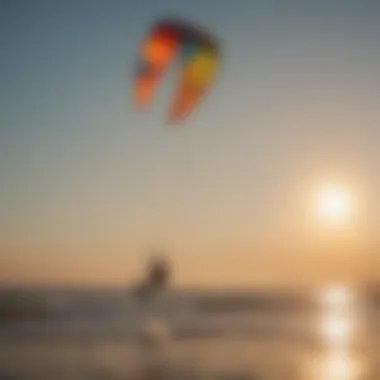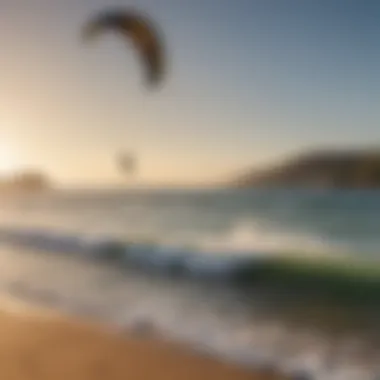Essential Guide to Kiteboarding Gear and Equipment


Equipment Reviews
Kiteboarding relies heavily on the correct equipment, which tactically influences performance, safety, and enjoyment. We'll explore the essential gear for practitioners at every skill level.
Kites
Kites are at the heart of kiteboarding, and understanding their variations is crucial.
Overview of Latest Models: Current market offerings include various brands like North Kiteboarding, Cabrihna, and Duotone, presenting unique features. Modern kites are designed for enhanced efficiency and stability.
Kite Shapes: Shape influences performance. Common shapes include delta, bow, and C-kites. Delta kites offer versatility and are user-friendly. Bow kites excel in light winds, while C-kites are designed for power and tricks.
Sizes: The size of a kite directly correlates with wind conditions and rider weight. Larger kites generate more lift in light winds, while smaller kites offer better control in stronger winds.
Materials: Fabrics such as ripstop nylon are standard, providing durability and lightweight properties.
Boards
The choice of boards plays a huge role in the kiteboarding experience. Different styles cater to different riding preferences.
Twintip Boards: These are versatile and suitable for most conditions. They provide ease of use for beginners and allow for tricks. Brands like Slingshot and Liquid Force offer numerous models.
Directional Boards: Ideal for wave riding and advanced maneuvers. These boards are designed for specific styles, allowing experienced riders more freedom to explore challenging conditions.
Accessories
Accessories are often overlooked but are essential for safety and performance.
Harnesses: A good harness provides support and stability. Waist and seat harnesses are available to cater to varying preferences.
Lines: The quality of lines affects control and responsiveness during a ride. Ensure that your lines are strong and properly maintained.
Pumps: An efficient pump is vital for quick inflation and deflation of kites.
Safety Gear: Wearing a helmet and impact vest should be a standard practice. These items safeguard against unfortunate falls and collisions.
Travel Destinations
Kiteboarding is equally about technique and experience with the right conditions and locations.
Popular Spots
Several locations are known for their ideal kiteboarding environments.
Tarifa, Spain: Dominated by reliable winds, this location offers both flat water and waves.
Cabo Verde: Known for its stunning landscapes and consistent trade winds, it provides a perfect setting for kite enthusiasts.
Off the Beaten Path
Some hidden locations cater to the adventurous.
Baja California, Mexico: Quiet spots with beautiful beaches and less crowded waters.
Paje, Zanzibar: This location offers unique cultural experiences along with favorable conditions for kiteboarding.
Techniques and Tutorials
Understanding techniques can elevate your experience, whether you are new or seasoned.
Beginner Guides
Learn the basics, such as launching, riding, and landing. Start with simple steps to master the necessary skills.
Advanced Skills
Advanced riders can explore maneuvers like jumps and tricks. Breaking down these techniques into manageable steps can enhance learning and performance.
Safety Guidelines
Safety is paramount in kiteboarding.
Weather Conditions
Be aware of wind, tides, and weather changes. Check weather forecasts and use local knowledge as a resource for safe practices.
Emergency Protocols
Know rescue tactics and emergency measures. It is vital to prepare for any mishaps that might occur.
Equipment Maintenance
Regular checks of equipment ensure it functions properly. Inspect lines, kites, and accessories frequently to maintain safety while enjoying the sport.
Regular maintenance of gear not only extends its life but enhances performance, making each ride enjoyable.
By understanding and carefully selecting the right equipment, kiteboarding can be a safe and rewarding activity, allowing riders to truly enjoy the exhilaration of the sport.
Prelims to Kiteboarding Equipment
Kiteboarding requires a careful consideration of various types of equipment. Understanding these necessities is not only important for enjoyment but also for safety and performance on the water. Each piece of equipment interacts with the others to create a cohesive kiteboarding experience. This introductory section outlines the essentials and frames the importance of selecting quality gear.


Overview of Equipment Categories
Kiteboarding equipment can be categorized into several key areas. These categories provide clarity in understanding the unique functions and purposes of each component. The main categories include kites, control systems, boards, safety gear, harnesses, wetsuits, and transportation solutions.
- Kites - The heart of kiteboarding. They come in various styles like inflatable kites and C-kites, impacting performance based on wind conditions.
- Control Systems - This includes the bars and lines that allow the rider to steer and control the kite. A reliable control system ensures safety during intense wind conditions.
- Boards - The platform on which the rider stands. This can be directional, twin-tip, or foil boards. Each type is suited for specific styles of kiteboarding.
- Safety Gear - Helmets, impact vests, and buoyancy aids are critical for reducing injury risk. Safety should always be a priority in any extreme sport.
- Harnesses - These connect the rider to the control system and help distribute force evenly, allowing for better control and comfort.
- Wetsuits and Apparel - Necessary for thermal protection, these come in various types depending on water temperature and individual comfort.
- Transport and Storage - Kite bags and board bags are essential for protecting gear during transport and while in storage.
Importance of Selecting the Right Gear
Choosing the right kiteboarding gear is crucial for several reasons. First, it ensures safety in the water. A poorly suited kite can lead to accidents, while inadequate safety gear can increase the risk of injury. Second, suitable equipment enhances performance. Gear that matches a rider's skill level supports progress in the sport.
When selecting gear, consider the following factors:
- Skill Level: Beginners should prioritize stability and ease of use. Experienced riders may opt for advanced kites that offer higher performance.
- Local Conditions: Understand local wind and water conditions. This affects the type of kite and board suited for your needs.
- Personal Preferences: Comfort and style play significant roles in enjoyment. Make sure to choose gear that feels right.
"The right equipment can make the difference between a good day on the water and a dangerous situation."
Kite Types and Characteristics
Understanding the different kite types is fundamental for any kiteboarding enthusiast. The type of kite you choose greatly impacts your performance, safety, and overall experience on the water. Each kite has unique characteristics, offering specific advantages and disadvantages depending on various conditions such as wind and water state. Recognizing these factors ensures that you select a kite that aligns with your skill level and the nature of your riding environment.
Inflatable Kites
Inflatable kites dominate the market due to their versatility and ease of use. These kites rely on air chambers that keep them inflated while flying. The lightness of the material allows for higher lift and stability in a variety of wind conditions. One major benefit is their ability to relaunch from the water effortlessly, making them suitable for beginners and experienced riders alike.
Inflatable kites come in different sizes, allowing customization for varying wind strengths. A larger kite is excellent for light winds, while a smaller kite performs better in strong winds. Their built-in safety features, such as quick release systems, also enhance rider safety—a crucial aspect of kiteboarding.
C-Kites
C-kites are recognized for their distinct C-shaped design, providing direct steering and high responsiveness. They are traditionally favored by freestyle riders, owing to their strong lift and ability to perform tricks with precision. These kites provide a reduced amount of power in low wind conditions but excel in high wind conditions due to their stability and control.
Due to their characteristics, C-kites require advanced skills to handle effectively. They allow experienced riders to execute aggressive maneuvers with relative ease. However, beginners might find them challenging, especially during relaunch from the water. Choosing a C-kite should be based on your riding skills and intended style of kiteboarding.
Delta Kites
Delta kites have gained popularity thanks to their enhanced performance and stability. Their shape resembles a delta, offering a larger surface area which translates to significant lift. They are designed for ease of use, making them appealing for both beginners and seasoned kiteboarders. Delta kites excel in low wind conditions, showcasing their versatility on the water.
One notable advantage is its ability to relaunch with minimal effort, a feature particularly beneficial for less experienced riders. With a wide range of sizes available, delta kites can cater to various rider weights and wind conditions. However, their more complex design may require careful maintenance to ensure optimal performance.
SLE (Supported Leading Edge) Kites
The Supported Leading Edge design combines aspects of inflatable kites and C-kites, resulting in enhanced stability and performance. SLE kites are often used in various riding conditions, excelling in both freestyle and wave riding. Their characteristics allow for a smooth ride, even in choppy waters, making them a favorite among all skill levels.
These kites offer great versatility and can be tuned for different conditions. They provide reliable power and control without overwhelming the rider. Riders should consider their preferences and riding style when selecting an SLE kite. Overall, the right kite can significantly enhance the kiteboarding experience, allowing for a more enjoyable time on the water.
Control Systems and Bar Setup
In kiteboarding, the control systems and bar setup are crucial for a successful ride. They connect the kite and the rider, allowing precise navigation and control. Understanding how these components work together can significantly enhance performance and safety on the water.
Kite Control Bars
Kite control bars are the primary interface between the rider and the kite. They consist of a horizontal bar and two lines that connect to the kite, enabling control over its movement. The length and width of the bar play a key role in determining how responsive the kite will be. A wider bar provides more control for large kites, while a narrower bar can be better for smaller models.
Key Features:
- Material: Most bars are made from lightweight materials, often aluminum or carbon, to balance durability and weight.
- Grip: The texture on the bar ensures a firm hold, allowing for better control, particularly in challenging conditions.
It's important to choose a bar that fits your hands comfortably. If the grip is too small or too large, it may hinder your control of the kite. Always test different bars before making a decision.
Safety Features in Control Systems
Safety is paramount in kiteboarding, and the control systems offer vital features to protect the rider. An effective safety system can prevent accidents caused by equipment failure or sudden changes in wind conditions.
Common Safety Features:
- Quick Release Mechanisms: This allows the rider to release the kite instantly in emergencies, preventing potential accidents.
- Depower Systems: These systems reduce the kite's power instantly, giving the rider a chance to regain control overwhelmingly.
It is essential to familiarize yourself with these safety features and practice using them in a controlled environment.
"A good understanding and regular practice of safety systems can save lives in extreme sports."
Line Setup and Maintenance
Lines are an often-overlooked part of kiteboarding equipment, but they are fundamental to the overall performance. Proper line setup ensures that the kite functions as intended, providing necessary support and responsiveness.
Key Considerations:
- Length: The length of the lines affects how the kite flies. Longer lines allow for higher jumps and more power, while shorter lines offer more maneuverability.
- Tension: Check the tension of the lines regularly. Uneven tension can lead to poor performance and accidents.
- Maintenance: Together with checking the lines for wear and tear, it is important to regularly wash them to remove sand and salt, which can deteriorate their condition over time.
Creating a consistent maintenance routine is crucial. Ensuring that lines are straight and without knots before each ride can prevent issues in performance and ensure safety. Regular inspections will keep you riding safely and effectively.
Overall, a comprehensive understanding of control systems, bar setup, and maintenance challenges will enhance performance and safety in kiteboarding. This knowledge is indispensable for both novice and seasoned kiteboarders.
Boards for Kiteboarding
Boards are a foundational element of kiteboarding equipment. Their selection impacts performance, comfort, and overall experience. When considering boards, one must evaluate various factors such as riding style, skill level, and environmental conditions. A perfect board complements the kite by providing the necessary dynamics for speed, control, and maneuverability. Each style of board offers unique benefits, making it essential to understand their characteristics.
Directional Boards
Directional boards are typically used for wave riding and freestyle kiteboarding. These boards have a specific nose and tail design, allowing riders to navigate through the surf or wind conditions effectively. These wings are often longer and narrower compared to twin-tip boards. This shape enhances performance during downwind riding.
Benefits of Directional Boards:


- Optimized for wave conditions and downwind rides.
- Increased stability and tracking ability.
- The ability to carve effortlessly.
When choosing a directional board, consideration of the material and shape is important. Material influences weight, flex, and responsiveness. For instance, boards made from high-density foam offer better buoyancy and durability.
Twin-Tip Boards
Twin-tip boards are versatile and designed for both beginners and experienced riders. These boards have symmetrical ends, allowing riders to switch directions with ease. This design means they excel in freestyle riding and flatwater conditions, where jumps and tricks occur frequently.
Key Considerations for Twin-Tip Boards:
- Availability of different sizes to suit various rider weights and preferences.
- Suitable for multiple riding conditions—from flat water to chop.
- Variety of flex options to suit skill levels and styles.
Twin-tip boards often come with fin systems that improve grip and upwind performance. Riders can adjust this based on their personal preference.
Foil Boards
Foil boards represent an innovative shift in the kiteboarding experience. These boards feature a hydrofoil beneath, allowing the board to lift above the surface of the water. This lift reduces drag significantly, enabling riders to experience a smoother ride even in light wind conditions.
Advantages of Foil Boards:
- Ability to ride in very light wind conditions.
- Minimal drag allows for high speed and efficiency.
- Offers a unique sensation of flying above the water.
However, foil boards require precise skill and balance. They are less forgiving for beginners but offer an exhilarating experience for advanced riders. Understanding how to set up and operate a foil board is crucial.
"Selecting the right board is just as important as the kite itself; it determines how well you can harness the wind's power while enjoying your ride."
In summary, each type of board—directional, twin-tip, and foil—serves a distinct purpose within the realm of kiteboarding. Identifying the appropriate board for individual preferences will enhance skill development and overall satisfaction in the sport.
Safety Gear
Safety gear is an essential component of kiteboarding, as it enhances both the protection and confidence of the kiteboarder. The unpredictable nature of wind and water makes being prepared paramount. Effective safety equipment not only minimizes chances of injury but also allows individuals to focus on enjoying the sport. Thus, selecting appropriate safety gear should not be overlooked.
Impact Vests
Impact vests are crucial for protecting the torso. They provide cushioning during falls, which can often occur while kiteboarding. The material and design of these vests allow for flexibility and comfort, while still maintaining a layer of padding. Most impact vests are lightweight and feature a snug fit, ensuring they do not hinder mobility.
When choosing an impact vest, consider the following:
- Fit and Comfort: The vest should closely fit the body, avoiding any excessive bulk.
- Responsiveness: It should not restrict movement during performance.
- Material Durability: Look for vests made from high-quality materials to withstand wear and tear.
An effective impact vest can significantly reduce the risk of injury from hard landings or collisions.
Helmets
In resembling other high-adrenaline sports, helmets are a necessity in kiteboarding. They protect against head injuries related to falls, impacts, or accidental collisions with the kite or board. Not all helmets are the same; some are designed explicitly for kiteboarding, featuring quick-release mechanisms and reinforced materials.
When selecting a helmet, keep in mind:
- Certification: Choose helmets that meet safety standards, such as CE certification.
- Comfort: Adjustable sizing is vital for achieving a snug fit.
- Aerodynamic Design: Look for a helmet that minimizes drag during high-speed maneuvers.
Using a helmet significantly improves safety while kiteboarding, especially for those who enjoy more extreme conditions.
Buoyancy Aids
Buoyancy aids, often referred to as buoyancy vests, are another key piece of safety gear. They help increase a rider's flotation in case of emergencies, providing peace of mind while riding. Unlike life jackets, buoyancy aids generally offer less bulk and are designed to allow for a greater range of movement.
Factors to consider when choosing buoyancy aids include:
- Flotation Level: Opt for aids that offer sufficient flotation for your weight and skill level.
- Comfort and Fit: Make sure the buoyancy aid is not too loose or overly tight.
- Breathability: Many modern designs incorporate breathable materials, enhancing comfort during extended wear.
Harnesses and Their Functions
Harnesses play a crucial role in kiteboarding, connecting the kite to the rider in a way that optimizes comfort and control. The primary function of a harness is to transfer the pull from the kite to the rider's body, allowing the rider to manage the kite effectively without excessive fatigue or strain. A properly fitting harness enhances performance and provides safety, making it an integral piece of equipment for kiteboarding.
Types of Harnesses
There are generally two main types of harnesses used in kiteboarding: waist harnesses and seat harnesses.
- Waist Harness: This type sits around the waist and is more suitable for freestyle and freeride kiteboarding. It offers greater mobility and is preferred by many advanced riders for its flexibility.
- Seat Harness: This harness fits around the rider's hips and thighs, providing more support and stability. It is a good choice for beginners or those who favor a more relaxed style of riding.
Additionally, there are variations like hybrid harnesses, which combine features of both types. Each harness type has its advantages and should be chosen based on the rider’s style, skill level, and preference.
Choosing the Right Harness
When selecting a harness, several considerations are essential:
- Fit and Comfort: An ideal harness should fit snugly without being too tight. It should not restrict movement or dig into the body. Trying on various models will help find one that feels right.
- Support Level: Depending on riding style, some may need more back support than others. Seat harnesses offer more support, while waist harnesses provide a freer feel.
- Adjustability: A harness should have adjustable straps to ensure a tailored fit. This is particularly important when wearing thick wetsuits.
- Materials: Look for durable materials that allow for breathability and water resistance. A light harness can enhance performance during long sessions.
- Safety Features: Check for safety components, like quick-release systems, that facilitate easy detachment in emergencies.
"A well-chosen harness significantly affects comfort and performance in kiteboarding. The right fit leads to longer sessions and a more enjoyable experience."
In summary, understand the importance of harnesses before setting off on the water. Evaluating the types and considering personal needs will enhance your kiteboarding journey.
Wetsuits and Apparel
Wetsuits and apparel represent a crucial aspect of kiteboarding. Selecting the right clothing enhances comfort and safety while participating in the sport. The right gear protects against adverse weather conditions, provides thermal insulation, and allows for ease of movement. Understanding various wetsuit types, layering techniques, and appropriate accessories can greatly improve performance on the water. This section will cover all critical elements concerning wetsuits and apparel to aid kitesurfers in making informed choices.
Wetsuit Types
Wetsuits come in several types, each designed for specific conditions and activities. Here are the most common types:
- Full Wetsuits: These provide maximum thermal protection, covering the entire body. They are ideal for colder waters where warmth is essential.
- Shorty Wetsuits: These are shorter versions and only cover the torso and the upper part of the arms and legs. They are suitable for warmer temperatures.
- Surf Suits: These are lightweight and allow for maximum mobility. They are designed primarily for surfers but also work well for kitesurfing in warm conditions.
- Hybrid Suits: These combine features from different wetsuit types. They often have different thicknesses in various areas to balance warmth with flexibility.


When selecting a wetsuit, consider the water temperature and how long you plan to be in the water. This will help you choose the most suitable type.
Layering for Temperature Control
Layering is an effective strategy to maintain comfort in varying temperatures. Using layers allows kitesurfers to adjust to changing weather conditions. Here are some tips for effective layering:
- Base Layer: Start with a thin, moisture-wicking fabric that sits next to the skin. This layer helps to draw sweat away and keeps the body warm.
- Insulation Layer: Use a thicker, thermal layer made of neoprene or fleece. This layer provides additional warmth without sacrificing mobility.
- Outer Layer: A lightweight windbreaker or waterproof jacket serves as the last line of defense against wind and rain.
Effectively combining these layers can keep body temperature stable, allowing for a more enjoyable and focused kiteboarding experience.
Footwear and Accessories
Footwear and accessories play a significant role in overall kiteboarding comfort and safety. It is essential to invest in good quality items to ensure a better experience.
- Booties: These provide protection against colder water and sharp objects like shells or rocks. Neoprene booties come in various thicknesses.
- Gloves: Wearing gloves helps retain heat in colder conditions and protects hands from abrasions.
- Hoods: In frigid conditions, hoods can be paired with wetsuits to warm the head and prevent hypothermia.
- Sunglasses: Polarized sunglasses can protect eyes from harmful UV rays and glare off the water. Use a secure strap to keep them in place while kitesurfing.
Investing in quality footwear and accessories not only enhances comfort but also may prevent injuries, allowing you to enjoy your time out on the water.
In summary, the right wetsuits and apparel significantly enhance the kiteboarding experience. Choosing suitable types of wetsuits, employing effective layering strategies, and selecting proper footwear and accessories can lead to a safer and more enjoyable time on the water.
Understanding these elements is paramount for both novice and experienced kiteboarders.
Transporting and Storing Equipment
Transporting and storing kiteboarding equipment is a crucial aspect of maintaining gear quality and ensuring a long lifespan. Kiteboarding involves various types of gear, including kites, boards, and harnesses, all of which can be damaged if not properly handled. Improper transportation can lead to wear and tear, compromising both performance and safety.
When selecting storage and transportation solutions, consider the materials and construction of the bags. Quality kite bags provide adequate protection against moisture, dust, and physical impacts. Both kite bags and board bags should be sturdy, with adequate padding to safeguard the delicate components of your gear. Choose bags designed specifically for your equipment as they often include compartments for smaller items, helping to keep everything organized.
Transporting your gear also includes considerations related to vehicle storage. Ensure that your equipment is secured during transport. Loose equipment can shift and lead to damage. Using straps or nets in your trunk or on a roof rack can prevent movement. Furthermore, keep equipment in a cool, dry place to avoid issues with humidity and heat, which can degrade materials.
Kite Bags and Board Bags
Kite bags and board bags serve multiple purposes, providing protection, convenience, and organization. Kite bags come in various sizes and designs, some are specifically made for inflatable kites and include pockets for accessories such as lines and safety gear. These pockets help ensure all your necessary tools are in one place.
Board bags often feature more padding, crucial for protecting your board during transport. When selecting a board bag, consider whether you will travel frequently or if you will primarily use it for local trips. A more robust, padded option may be worthwhile for regular travel, while a lighter bag may suffice for occasional use.
Here are some tips on choosing kite bags and board bags:
- Size: Ensure the bag accommodates your specific kite or board size.
- Padding: Look for bags with sufficient padding for protection from impact.
- Material: Choose durable, waterproof materials to protect your gear from the elements.
- Carrying Options: Consider how you will transport your gear. Bags with shoulder straps or handles can be easier to carry.
Maintenance Tips
Proper maintenance of your kiteboarding equipment is essential for performance and safety. Regularly inspect your kites, lines, and boards for any signs of wear or damage. Look for frayed lines or punctures in the kite fabric. Early detection of issues can prevent accidents.
Store your gear in cool, dry places when not in use. This minimizes exposure to humidity, which can harm materials over time. Additionally, rinse your kites and boards with fresh water after saltwater use to remove any residual salt that can cause corrosion.
For your lines, ensure they are well-maintained. Store them loosely to avoid tangling. Clean them periodically to enhance longevity.
- Check: Regularly inspect all components.
- Clean: Rinse off salt and sand after surfing.
- Store: Keep gear in a dry and temperature-controlled environment.
"The preservation of kiteboarding gear directly influences not just the gear's lifespan, but also the overall kiteboarding experience."
Taking the time to care for and store your equipment wisely results in better performance and safety during your kiteboarding adventures.
Future Trends in Kiteboarding Equipment
As kiteboarding continues to evolve, it is essential to examine the future trends that may shape the sport. This section highlights significant changes in gear and technology, impacting performance, safety, and user experience. The kiteboarding landscape is constantly shifting, driven by advancements that not only enhance the enjoyment of the sport but also improve safety standards and accessibility for newcomers. Understanding these trends helps riders choose equipment that meets their current and future needs.
Innovative Materials
Kiteboarding gear is seeing a substantial shift towards the use of innovative materials. Materials like Dyneema and other high-modulus polyethylene are becoming more prevalent due to their strength and durability. These advancements allow for lighter kites and boards without sacrificing performance or safety. Moreover, manufacturers are now exploring eco-friendly materials to lower the environmental impact of producing kiteboarding equipment. This movement not only fosters a more sustainable approach to the sport but also attracts environmentally conscious athletes.
Benefits of these materials include:
- Enhanced durability against wear and tear.
- Improved performance by reducing overall weight.
- Increased responsiveness and control for the rider.
These developments show promise in improving the longevity of kiteboarding gear, providing value to riders in the long run.
Technological Advances
Recent technological advances in kiteboarding equipment are revolutionizing the sport. From smart kites equipped with sensors to real-time performance monitoring, technology is effectively enhancing the kiteboarding experience. Innovations such as GPS integration allow riders to track performance metrics like speed and altitude, offering in-depth analysis and feedback.
Some notable advances include:
- Smart control bars that adjust automatically to wind conditions.
- Kites with built-in systems for instant depowering in adverse conditions, boosting safety.
- Enhanced design features that improve downwind efficiency.
As these technologies become more widely adopted, they are set to redefine how kiteboarders interact with their equipment and the environment. It is crucial for riders to stay informed about these developments, as they not only improve performance but also add layers of safety and enjoyment to the sport.
Culmination on Equipment Selection
The selection of kiteboarding equipment stands as a pivotal aspect within the sport. Proper gear can significantly affect performance, safety, and overall enjoyment. Individuals must carefully assess their personal requirements to ensure optimal equipment choice. This section synthesizes the various elements to consider when making informed selections, focusing on key benefits that tailored equipment can provide.
Assessing Personal Needs
Understanding personal needs is fundamental in kiteboarding. Multiple factors influence these needs, including skill level, riding style, and local conditions. Beginners may prioritize ease of use and safety, while advanced riders may look for performance specifications that align with their preferred tricks and maneuvers.
- Skill Level: A novice may require more forgiving gear that enhances stability, while experts will benefit from precision-engineered equipment.
- Riding Style: Freestyle, wave riding, and cruising require distinctive characteristics from boards and kites. A clear understanding of one’s riding style will aid in choosing appropriate gear.
- Environmental Conditions: Different kites and boards perform uniquely in various wind and water conditions. For example, robust winds necessitate a different kite size than lighter winds.
By evaluating these elements, a kiteboarder can select equipment that aligns with their unique requirements and preferences. This provides both an enjoyable experience and a learning curve conducive to skill development.
Continuous Learning and Adaptation
Kiteboarding is a sport that evolves constantly, reflecting trends in technology, materials, and practices. Continuous learning is crucial. As kiteboarders become more experienced, they may find that earlier choices no longer meet their evolving needs. Staying informed about equipment advancements and changes in technique can lead to significant improvements in performance.
Regularly reviewing personal equipment and considering any necessary upgrades ensures that the gear remains suitable. New materials, such as lighter yet durable fabrics, can enhance performance. Adaptation often leads to better control, increased safety, and a richer experience on the water.
"Technology in kiteboarding is always improving. Staying updated helps you make better choices."
In summary, selecting the right kiteboarding gear is not a one-time decision but an ongoing process. By assessing personal needs and committing to continuous adaptation, one can maximize their kiteboarding adventure. The synergy of customizing gear with personal growth affords kiteboarders an effective path to mastery and enjoyment in this dynamic sport.







